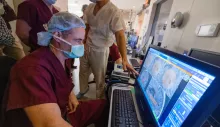Sudden Unexpected Death in Epilepsy (SUDEP)
- For all other requests:
- 1-888-573-5437
Sudden unexpected death in epilepsy (SUDEP) refers to when an otherwise healthy child with epilepsy dies unexpectedly.
Most children with epilepsy grow up to live long, healthy lives, but the risk of unexpected death is still a major concern for parents. However, SUDEP in children is rare. Each year, it is estimated that 1 out of 4,500 U.S. children with epilepsy die from SUDEP.
University of Iowa Health Care Stead Family Children’s Hospital’s neurology and neurosurgery specialists are experts in the diagnosis, treatment, and management of epilepsy and can design a treatment plan for your child that helps reduce their risk of SUDEP.
Neurologists and neurosurgeons at UI Health Care are nationally recognized for their expertise on SUDEP. We are only of only a handful of medical centers to collaborate with the Center for SUDEP Research and the National Institutes of Health to help pinpoint the causes of SUDEP and stop it from happening.
We’re also the first and only health system in Iowa accredited as a Level 4 epilepsy center by the National Association of Epilepsy Centers (NAEC). This is the highest designation an epilepsy center can achieve.
Causes of SUDEP
A key risk factor for SUDEP is epilepsy which is not well controlled by treatments like medication or surgery. While the exact cause of SUDEP is unknown, increasing evidence suggests that loss of breathing, or apnea, that persists after a seizure is a major cause of SUDEP.
In fact, UI Health Care neuroscientists have found that when a seizure spreads to a specific brain area, it causes prolonged loss of breathing even after a seizure has ended.
Most SUDEP deaths occur from experiencing a seizure while sleeping. These seizures can cause complications such as:
In rare instances, a seizure can lead to a change in heart rate or rhythm, or even trigger a heart attack.
Seizures can cause a person to stop breathing for a small amount of time. If these pauses last too long, it can cause a life-threatening lack of oxygen. It can also lead to suffocation if the airway is blocked during the seizure.
Who is at risk of SUDEP?
Anyone who has epilepsy has a risk of SUDEP. However, children with frequent, tonic-clonic (grand mal) seizures are at an increased risk.
Reducing your risk of SUDEP
The best way to reduce your child’s risk of SUDEP is to work with their care team to control their seizures. This could include:
This means your child taking seizure medication as prescribed, attending regular appointments with your child’s provider, and possibly opting for advanced treatment options, such as surgery, neurostimulation devices, clinical trials, or dietary therapy.
Eating better, getting enough rest, and minimizing stress can all help to improve overall health and reduce seizures.
Keep notes about what occurred before a seizure. This could help you better understand what triggers your child’s seizures, so you can plan to avoid those triggers as much as possible.
Our Care Team






- Department of Pediatrics
- Neurology


- Department of Pediatrics
- Neurology








- Neurology
- Neurology
- Neurology
Need help finding an epilepsy specialist?
Locations and Offices


Related News
